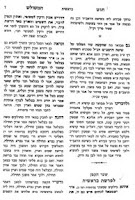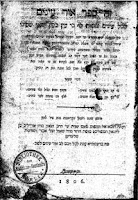Midrash Lekah Tov, part Deux
It was not until 1880 was the full edition on the Torah published by Dr. Solomon Buber. I have used the Dr. appellation as he had a doctorate but I am unsure if he had semikha, this however, is not a bar to the use of the Rabbi appellation, as in the Vilna Shas in the Achrit Davar at the end of Mesekhet Niddah, he is referred to as R. Solomon Buber. Dr. Solomon Buber dedicated this work to the memory of his father, R. Yeshaiah Avraham Halevi. Additionally, the portions on the five Meggilot were published around that time for the first time as well, Esther 1886, Ruth in 1887, Eicha in 1895 (there was an edition published the next year in Calford, England, which was touted as the first edition, in actuality it was the second edition), Kohelet in 1904, Shir haShirim in 1909. Now, as Prof. Horowitz has noted, Makhon Zikhron Ahron has republished the section on the Torah and five Meggilot with Buber’s comments as well as a few notes from R. Yerucham Fishel Perla.
Although they neglect to mention where they located that R. Perla’s notes, appeared 50 years ago in the journal Hadarom which they most probably found in Sa’rei haElef. Aside from the above they reset the type. Importantly, however, the text remains the same as it was in 1880. A simple search of the Jewish National and University Library (JNUL) catalog reveals that there are at least sixty some manuscripts available, most were neither available nor used by Buber in his edition, but nor are they used in this edition.
Instead, our edition is frozen in the late nineteenth-century. These manuscripts contain much additional information as was already pointed out by Prof. Yisrael Ta-Shema in his article on this work. Now, lest one think that Buber’s edition the type was unreadable, rather it was a highly readable edition, further, it was not unavailable, but instead reprinted on many occasions in photomechanical offsets, and in fact, as Prof. Horowitz noted, this new edition the Greek is almost unreadable as they did it by hand or via cut and paste. Why then this work was republished in this “special” edition but remained as it was is rather unclear.
This is not the only time this Makhon has failed to use important manuscripts when reprinting something. Additionally, this same Makhon reprinted the Perkei D’Reb Eliezer. What is shocking about this is that there are very important manuscripts, manuscripts which this Makhon did not bother using, which one doesn’t have to even go to a library, they are online! There is an entire project devoted to the correct text of the Perkei D’Reb Eliezer. Instead, as they did here, they merely reset the type and reprinted the Perkei D’Reb Eliezer. Of course, no one is obligated to use every manuscript, but when as is the case both here and in the case of the Perkei D’Reb Eliezer, the prior editions are available, what is the point in merely resetting the type and reprinting the books? A good example of a reprint where it was valuable was the case, by this same Makhon where they reprinted and reset the type of some important unavailable works on the Shulhan Arukh, including R. Chaim Buchner’s Or Chadash, Nachlat Tzvi, and Olat Shabbat (which the Magen Avraham refers to by the abbreviation O.S. on many occasions). This as an excellent reprint as the earlier editions were difficult to come by and difficult to read. Or, again the same Makhon, reprinted the Levush. This edition is beautiful. They reset the type included, in the proper place both the Eliyahu Rabba and Zuta, the commentary of the Hida’s grandfather from manuscript, as well as notes and other commentaries. This is excellent and has now been reprinted in a smaller format. The Makhon also printed an edition of Perek Shira which has three commentaries from manuscript one being from R. Dovid Oppenheim, that was also very good. Thus, I want to make clear, that while the books such as Lekah Tov are disappointing, this Makhon has published some excellent works.
Now, however, it is worthwhile noting that this Makhon is set up as a public service and as such is not out to make money. And, it is highly laudable to reprint seforim, my point here, is to merely point out some areas where the Makhon can improve.
It may be instructive to discuss how we know what we already do about this work, and I apologize to those readers who already know this. First, as mentioned above, for bibliographical information on this sort of work, R. Menachem M. Kasher’s Sa’arei HaElef is irreplaceable. As noted above, he records that R. Y. Perla’s comments had been printed. Additionally, he provides the location of reviews on Buber’s edition. As this work was updated by Kasher’s student, Mandelbaum he also adds to this information as well. Recently, Prof. Simcha Emmanuel has updated Sa’arei HaElef as well but only the poskim portion, hopefully a full update will happen soon.
Setting aside the more general tutorial, wWe can turn to the work itself. Prof. Ta-Shema wrote an article which he intended to publish in Sidra, however, he died before he was able to submit the final version for publication. Nevertheless, in the posthumously published Keneset Mechkarim vol. 3 (pp. 259-94) we have this article, “Midrash ‘Lekah Tov’ – Its Historic Place and Purpose.” Prof. Ta-Shema reviews the work and points out important details. He discusses the various laws and customs gleaned from this work.
Particularly timely is the appearance, in this work, of the custom to blow the shofar during the month of Elul.[1] this work contains much in the way of explicating the law, one of the purposes is to demonstrate the close connection between the written and oral Torah and thus much is devoted to showing how the laws are derived from the Torah. This focus was in part to disprove the Karaites. And, as Ta-Shema notes, it was not only strictly legal questions which the Lekah Tov disputes with the Karaites, rather substative theory is addressed as well. This is one of the many times the various available manuscripts come into play. (See Ta-Shema pp. 269-71). There are numerous examples where Lekah Tov takes issue with the Karaites, including lights on Shabbat, Yemi Taharah, an established calendar, and Shavuot.
Ta-Shema notes that the style of this work is to explicate the verses in a fairly peshat oriented manner similar, although not the same, as Rashi. In fact, they were contemporaries. This fact is particularly important for understanding Rashi. Specifically, there is a question whether Rashi’s commentary on the Torah as we have it today is all from Rashi or have there been additions. Obviously, whether we can say all which is attributed to Rashi is in fact from him is rather important. The question with the Lekah Tov is that there appear quotes from the Lekah Tov in Rashi. Well then we must decide when the Lekah Tov was disseminated. As if it was not until after Rashi then it is clear that there must be at least some later additions to Rashi’s commentary, if Lekah Tov significantly predates Rashi then this poses no problem. But, this is all complicated by the fact the Lekah Tov seems to have used Rashi and visa versa. One possibility which would explain this is that both these works went through more than one edition, thus in the very first edition of Rashi he did not include the Lekah Tov, but after he got a hold of it and Rashi was revising his commentary he included those comments and the same for the Lekah Tov’s use of Rashi. According to this explanation the fidelity of Rashi is not questioned.[2] But, as is apparent this is a very important question, one which could have been explored had an attempt to reconstruct when and how many editions the Lekah Tov was originally written in and when.
As should be apparent, Prof. Horowitz’s criticism of this edition are well-founded. It is especially unfortunate that today when it is so easy due in part to the advances in technology that it seems at times we have not progressed at all.
Notes
[1] For more on this topic see, among others, Pardes Eliezer, Chap. 1, 29-88; Yehiel Goldhaber, Minhagei HaKehilot, pp. 5-8; Oberlander, Minhag Avoteinu, Vol. 1, chap. 1, 3-23; Daniel Sperber, Minhagi Yisrael, vol. 2 pp. 204-14.
[2] For more and additional sources discussing this question see Yisrael Ta-Shema pp. 266-7 n. 25; on the various edition of Rashi’s commentary to the Talmud see Y. S. Speigel, Amudim B’Tolodot Sefer HaIvri Kitva V’Hataka, pp. 113-22. The claim that a work attributed to an author is not fully from him is used by many to explain various perceived inconsistencies. As Prof. Marc B. Shapiro pointed out, in his recent post at the Seforim blog, R. Moshe used this to explain controversial comments of R. Yehuda HaHassid. See Speigel, id. pp. 271-75 and generally id. chapter 6 discussing responsa literature. For an example of this in the case of a Torah commentary see the comments of R. M.M. Kasher Torah Shelmah where he claims that a particularly controversial passage of the Ibn Ezra’s commentary where he seems to imply Moshe did not write various portions of the Torah was inserted later.





